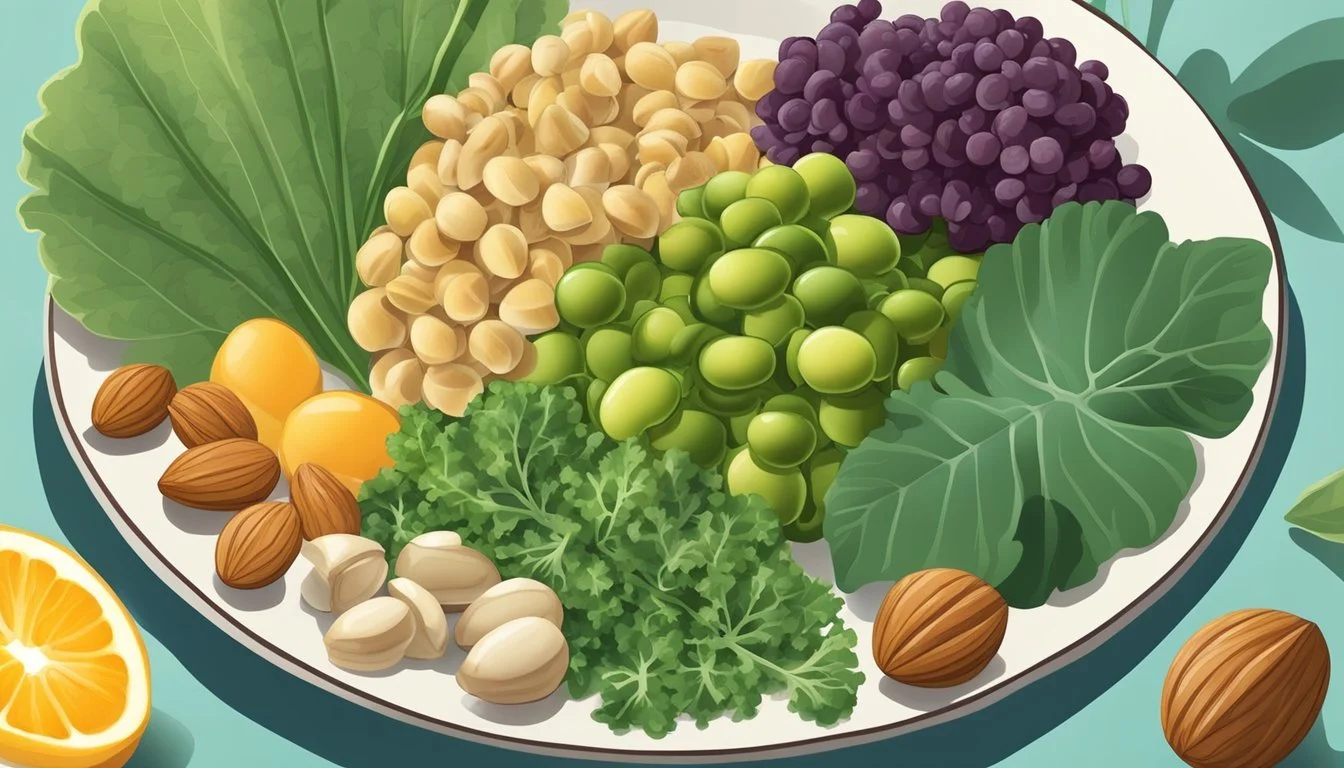Can Diabetics Eat Sea Grapes?
A Nutritional Overview
Sea grapes, a type of marine algae, have been gaining attention for their potential health benefits. For diabetics, managing diet is crucial, and the question arises, can sea grapes fit into a diabetic-friendly eating plan? The answer lies in understanding their nutritional profile and their impact on blood sugar levels.
Sea grapes are low in carbohydrates, which means they have a minimal effect on blood sugar levels. They are rich in essential nutrients like vitamins A and C, calcium, and magnesium, making them a nutritious option for those managing diabetes. Including sea grapes in your diet can offer variety without causing significant spikes in blood sugar.
Incorporating sea grapes into a balanced diet can help diabetics enjoy a healthy, nutritious addition to their meals. The combination of low carbohydrate content and high nutritional value makes sea grapes a favorable choice for maintaining stable blood sugar levels.
Understanding Diabetes and Diet
Managing diabetes involves careful planning of meals to maintain stable blood sugar levels. Specific attention to carbohydrate intake and the glycemic properties of foods is essential.
The Role of Carbohydrates in Diabetes Management
Carbohydrates play a significant role in diabetes management because they directly impact blood sugar levels. When consumed, carbohydrates are broken down into glucose, which enters the bloodstream. This causes a rise in blood glucose levels.
People with diabetes need to monitor their carbohydrate intake to avoid spikes in blood sugar. The American Diabetes Association recommends individual carbohydrate counting to help manage blood glucose. Typically, this involves measuring the grams of carbohydrates in each meal. Foods rich in carbohydrates include grains, fruits, vegetables, and dairy products, all of which must be accounted for in a diabetes-friendly diet.
Importance of Glycemic Index and Glycemic Load
The glycemic index (GI) and glycemic load (GL) are tools used to understand how different foods affect blood sugar levels. The GI measures how quickly a carbohydrate-containing food raises blood glucose levels. Foods with a high glycemic index cause rapid spikes, whereas those with a low glycemic index lead to slower increases.
Glycemic load takes into account both the glycemic index and the amount of carbohydrates in a serving of food. This makes it a more accurate measure of how a particular food impacts blood sugar.
For example, grapes have a low glycemic index, making them a good choice for people managing diabetes, provided they monitor their portions. By prioritizing foods with a low glycemic index and glycemic load, individuals can better control their blood sugar and insulin levels.
Nutritional Profile of Sea Grapes
Sea grapes, also known as Caulerpa lentillifera, are an edible green algae notable for their potential benefits for diabetics. They are packed with vitamins, minerals, fiber, antioxidants, and polyphenols, which contribute to their health-promoting properties.
Vitamins and Minerals in Sea Grapes
Sea grapes are rich in essential vitamins such as vitamin A, vitamin C, and several B vitamins. Vitamin A is crucial for maintaining healthy vision, skin, and immune function.
The algae also contain important minerals like calcium, magnesium, and potassium. These minerals play vital roles in bone health, muscle function, and regulating blood pressure. Additionally, the iodine content in sea grapes supports thyroid health.
Fiber Content and Its Benefits for Diabetics
Dietary fiber is a significant part of sea grapes, providing benefits for blood sugar management. Fiber slows the absorption of sugar into the bloodstream, helping to prevent spikes in blood glucose levels.
This quality is particularly helpful for diabetics who need to maintain stable blood sugar levels. Including fiber-rich foods like sea grapes in the diet can contribute to better glycemic control and overall metabolic health.
Antioxidants and Polyphenols in Sea Grapes
Sea grapes contain antioxidants and polyphenols, which help protect the body from oxidative stress and inflammation. Antioxidants such as vitamin C and beta-carotene neutralize harmful free radicals.
Polyphenols, found in the algae, have anti-inflammatory properties and may improve cardiovascular health. Consuming foods rich in antioxidants and polyphenols can support the body's defenses against various chronic diseases, including diabetes.
Potential Health Benefits of Sea Grapes
Sea grapes, also known as umibudo, offer numerous health benefits. They may improve blood sugar management, support heart health by lowering cholesterol, and possess anti-inflammatory properties that could help in cancer prevention.
Impact on Blood Sugar Management
Sea grapes contain a variety of nutrients like unsaturated fatty acids, which are beneficial for managing blood sugar levels. These fatty acids help improve the body's insulin sensitivity. Additionally, sea grapes have low glycemic index levels, which makes them a suitable food choice for individuals with diabetes.
For diabetics, integrating sea grapes into the diet can lead to better glucose control. The nutrient composition reduces the risk of sudden spikes in blood sugar levels, aiding in overall diabetes management.
Heart Health and Cholesterol
The unsaturated fatty acids present in sea grapes, such as DHA and EPA, contribute significantly to heart health. These compounds help in reducing bad cholesterol (LDL) while increasing good cholesterol (HDL).
By improving lipid profiles, these seaweed vines can decrease the risk of heart diseases such as coronary artery disease and hypertension. Regular consumption of sea grapes has been linked to maintaining cardiovascular health and supporting healthy aging.
Anti-Inflammatory and Cancer-Preventive Properties
Sea grapes have notable anti-inflammatory properties. These properties come from their rich content of antioxidants and polyphenols. Such compounds help in reducing inflammation, a contributing factor to many chronic diseases, including cancer.
Research suggests that the bioactive substances in sea grapes can inhibit the growth of cancer cells and reduce the risk of tumor formation. This seaweed's anti-inflammatory capabilities also assist in managing and preventing age-related ailments, promoting a healthier, longer life.
Incorporating Sea Grapes into a Diabetic Diet
Incorporating sea grapes into a diabetic diet can be both beneficial and enjoyable when done with attention to portion sizes and appropriate preparation methods. They offer unique nutritional benefits while adding variety to a diabetes-friendly meal plan.
Appropriate Portion Sizes
Sea grapes, like other fruits, should be consumed in moderation to maintain stable blood sugar levels. A standard serving size can be around half a cup. This portion provides necessary nutrients without excessively high carbohydrate intake.
It's important to integrate this portion into the overall daily carbohydrate count. Balancing sea grapes with other non-starchy vegetables can create a nutritious and satisfying meal.
Recommended Preparation Methods
Sea grapes are usually enjoyed fresh and can be eaten on their own or added to salads. Rinse thoroughly before consumption to remove any salt. They can also be paired with lean proteins or incorporated into low-carb recipes to add texture and flavor.
For a balanced approach, avoid adding high-calorie dressings or additional sugar. Instead, use lemon juice, olive oil, or herbs for seasoning. This helps maintain the nutritional integrity of the meal without unnecessary calorie spikes.
Alternatives to Sea Grapes for Variety
While sea grapes add a unique element to the diet, it's beneficial to include a variety of other whole fruits and non-starchy vegetables. Consider options like berries, green leafy vegetables, or cucumber. These alternatives offer nutritious benefits similar to sea grapes and can help prevent dietary monotony.
Creating a diverse and flavorful meal plan enhances the dining experience while ensuring balanced nutrition. Rotating different fresh produce can also provide a range of vitamins and minerals crucial for overall health.
Comparing Sea Grapes to Other Fruits
Sea grapes, while not as commonly discussed as other fruits, offer unique benefits and challenges for those managing diabetes. This section dives into how sea grapes stack up against typical fruits in a diabetic diet, as well as the impact of fruit juices and dried fruits.
Sea Grapes vs. Common Fruits in a Diabetic Diet
Sea grapes have a unique nutritional profile, featuring high water content and beneficial minerals. When compared to common fruits like apples, bananas, and traditional grapes, sea grapes stand out due to their low sugar content.
Traditional grapes offer antioxidants and have a low glycemic index, making them a suitable option for diabetics in moderate amounts.
In contrast, apples and berries, which are high in fiber, help slow the absorption of sugar, reducing spikes in blood sugar levels.
Bananas, especially when ripe, have higher sugar content, which could pose challenges for blood sugar management.
In conclusion, sea grapes may offer a good option for diabetics due to their low sugar content, but they should be consumed in moderation, much like other fruits.
Understanding Fruit Juices and Dried Fruits
The way fruits are consumed can significantly impact blood sugar levels. Whole fruits, including sea grapes, have a lower impact compared to their juiced or dried counterparts.
Fruit juices, even when freshly squeezed, often lack the fiber found in whole fruits. This loss of fiber can lead to quicker absorption of sugars and increased blood sugar spikes.
Dried fruits like raisins concentrate sugars as they lose water content. For example, dried grapes (raisins) have a much higher sugar concentration compared to fresh grapes.
Sea grapes in their whole form will have a lower glycemic impact than if they were consumed as juice or dried fruits. Consequently, for blood sugar management, sea grapes, like other fruits, are best consumed whole.
Dietary Considerations and Precautions
When it comes to incorporating sea grapes into a diabetic diet, it is essential to manage sweet tooth cravings, monitor the effects on blood sugar control, and be aware of potential risks and situations where sea grapes should be avoided.
Managing Sweet Tooth Cravings
Sea grapes can help satisfy sweet tooth cravings with their natural sweetness. They are low in natural sugars compared to many fruits, making them a better option for diabetics.
Consuming sea grapes in moderation can prevent spikes in blood sugar levels. Pairing them with a source of protein, like a handful of nuts, can also stabilize blood sugar levels. Keeping portions small is key to enjoying sea grapes without overindulgence.
Monitoring the Effects on Blood Sugar Control
Regular monitoring of blood sugar levels is crucial when introducing any new food, including sea grapes, into a diabetic diet. Although sea grapes have a relatively low glycemic load, each individual might react differently.
Using a glucose meter to track blood sugar before and after consuming sea grapes can help determine their impact. It's essential to look for any patterns of blood sugar fluctuations and adjust the quantity of sea grapes accordingly. Consulting with a healthcare professional can provide personalized guidance.
Potential Risks and When to Avoid Sea Grapes
Certain groups should exercise caution or avoid sea grapes altogether. Those with pre-existing conditions such as high blood pressure or kidney complications need to be vigilant due to the sodium content found in sea grapes.
Additionally, individuals must be aware of the potential for allergic reactions. Monitoring for any adverse symptoms is vital, and medical advice should be sought if any conditions worsen. If sea grapes cause significant spikes in blood sugar despite moderation, it might be best to exclude them from the diet.
Lifestyle and Dietary Synergy for Diabetes
Combining sea grapes with other nutritious elements like heart-healthy fats and adopting lifestyle modifications can significantly impact diabetes management. These strategies promote better insulin sensitivity and overall health.
Combining Sea Grapes with Heart-Healthy Fats
Sea grapes can be a tasty addition to a diabetes-friendly diet. Pairing sea grapes with sources of healthy fats may enhance their benefits. Consider adding them to salads with avocado, olive oil, or nuts.
Healthy fats stabilize blood sugar levels. They also support heart health, which is critical for people with diabetes. Including a small portion of sea grapes with fatty fish like salmon or mackerel can provide a well-rounded meal. The combination is beneficial for both blood sugar control and cardiovascular health.
Mediterranean Diet and Fruit Intake
The Mediterranean diet is renowned for its health benefits, especially for those managing diabetes. This diet emphasizes fruits, vegetables, whole grains, and healthy fats.
Incorporating sea grapes into a Mediterranean diet can be effective. Consume them along with whole grains like quinoa and bulgur for balanced nutrition. Heart-healthy oils such as extra virgin olive oil can be drizzled over sea grapes and vegetable dishes.
The Mediterranean diet enhances insulin sensitivity and reduces cardiovascular risks, making it ideal for diabetes management.
Beyond Diet: Whole Lifestyle Approaches
Managing diabetes extends beyond dietary choices. Incorporating regular physical activity, consistent sleep patterns, and stress management techniques are crucial.
Engaging in activities like walking, yoga, or cycling helps maintain healthy blood sugar levels. Adequate sleep is essential as it impacts insulin sensitivity.
Stress management through meditation or deep-breathing exercises prevents spikes in blood sugar levels.
A holistic approach that includes diet, exercise, and mental well-being addresses the multifaceted nature of diabetes management.






